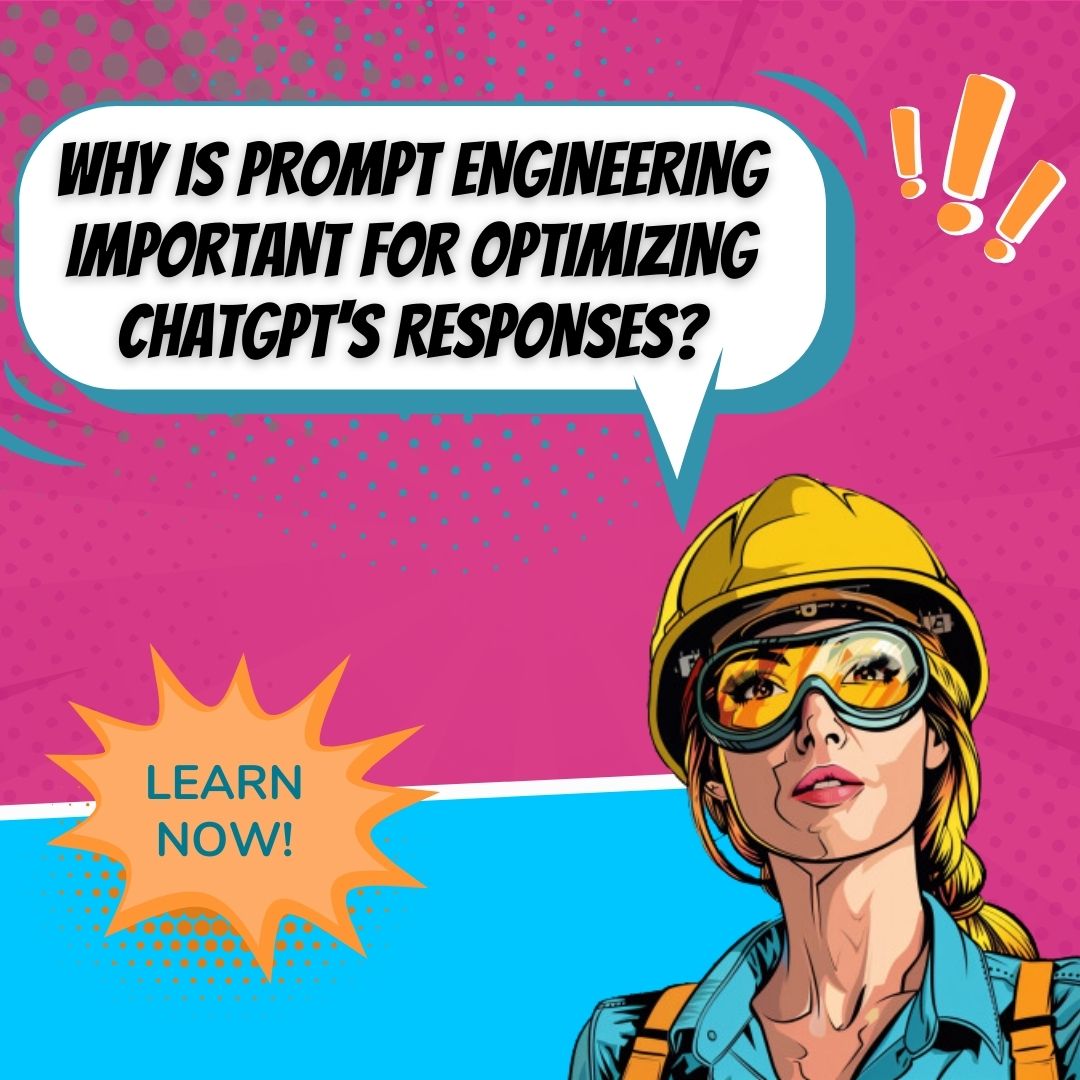Key Takeaways
✅ ChatGPT Prompt Engineering is the art of creating input that talks the language of AI, turning your words into precise, understandable commands. It's not just talking, it's talking smartly, steering ChatGPT to give you the best possible answers. It's like knowing the secret code to a hidden treasure of valuable insights.
✅ Why bother with crafting the perfect prompt? Because effective prompt engineering is like giving a map and a compass to a traveler - it leads to quality destinations of information, fast. In other words, your prompts are the key to turning a robotic chat into a human-like conversation that gets you the answers you need.
✅ For bulletproof prompts, keep it clear, keep it relevant, and keep it human. With these tips for successful prompts, you'll be chatting with ChatGPT like it's an old friend, getting precisely the insights you're after. It's not just about asking; it's about asking right, so each response is spot-on.

Introduction
Ever wondered why sometimes chatting with AI feels like trying to talk to a brick wall? That's where ChatGPT Prompt Engineering steps in. It's your key to unlocking the vast potential of ChatGPT, turning bot conversations into valuable exchanges of information.
But the trick is, how do you get an AI to understand you? How do you master the prompts that make ChatGPT snap to attention and deliver the goods? This guide is all about that – Mastering ChatGPT Prompt Engineering. It's not just talk; it's the kind of talk that sparks ideas, drives business growth, and answers the challenging questions with ease. Stick around, because by the end of this, you'll be writing prompts that get you exactly what you need, when you need it.
Top Statistics
| Statistic | Insight |
|---|---|
| ChatGPT Training Data: Trained on over 300 billion words. (Source: Perplexity) | This staggering number illuminates the extensive knowledge base ChatGPT draws from, enabling nuanced and responsive interactions. |
| Conversational AI Market Size: Valued at $4.8 billion in 2020 with a CAGR of 21.9%. (Source: Grand View Research) | This growth trajectory showcases the burgeoning demand and the vast potential for investment and innovation in the field of AI communication. |
| Chatbot Interaction by Age: More than 57% of users are aged between 18 and 34. (Source: Drift) | The youth-centric user base indicates a need for businesses to adapt to the preferences of a younger, tech-savvy demographic that values immediacy and conversational interaction. |
| NLP Market Projection: Potentially reaching $43.2 billion by 2025. (Source: MarketsandMarkets) | An insight into the expansive future of natural language processing, highlighting its importance in various technological applications and services. |
| Business Adoption: 50% of businesses use chatbots for customer service efficiency. (Source: Spiceworks Ziff Davis) | The statistic reflects the crucial role chatbots play in customer service transformation, aiming to achieve higher efficiency and satisfaction. |
Crafting the Perfect ChatGPT Prompt: A Guide to Getting It Right
Crafting a prompt for ChatGPT is like writing a good text message. Ever texted a friend for a favor? You need to be clear and to the point. Imagine asking them to pick up your favorite snack—will they know which one if you're not specific? Now put that into crafting prompts. Here's the deal: to craft a good effective prompt, you have two goals - being clear about what you need, and making sure you don't confuse the bot with unnecessary details.
So, what does a spot-on prompt look like? It's like telling a friend exactly where in the fridge your snack is. With ChatGPT, it means giving enough context. Say you're asking about the Eiffel Tower. Don't just ask, "Tell me about that tall thing in Paris." Mention the Eiffel Tower by name, and specify what you want to know—history, height, or maybe fun facts? And just like texting, the tone matters, too. Talk like you're asking a buddy a question—keep it friendly but clear.
However, don’t get too comfortable. Too casual and you might not be taken seriously, and too stiff might not get you the detailed, conversational response you want. It's a balancing act, just like choosing the right tone in a text so it's not misunderstood. Be the Goldilocks of prompt engineering—get it just right.
But, speaking of misunderstandings, you've got to be smart about follow-ups. Ever had to clarify a text? If ChatGPT's first response isn't quite there, you guide it. Just like you might text back, "No, the other snack, the one with chocolate!" A follow-up gives ChatGPT a nudge closer to what you're looking for.
Remember, try to sidestep those pitfalls. You want your friend to understand your text, right? If you're too vague or ramble on, they might grab the wrong snack. It's the same when talking to ChatGPT. Keep it precise and avoid ambiguity. Just think before you "send" —make sure you're only including details that'll help it get the job right.

Now, about those advanced strategies—like Tony Stark in his workshop, sometimes you need to mix and match tools or tweak your approach for even better results. That could mean breaking your query into parts for more complex questions, or using ChatGPT alongside another tool or database for an extra boost.
Ready to become a prompt genius? Great! Remember, it all starts with a single, well-thought-out message. Like writing that perfect text, it's about getting your point across clearly and efficiently. What's your next prompt going to be?
Mastering the Art of Follow-Ups with ChatGPT
Now that you've sharpened your precision tool and set the context compass in the right direction, let's talk progress. Ever had a chat when one question led to another, fleshing out a full story? It works similarly with ChatGPT follow-ups. Crafting these follow-ups is a delicate dance. You lead, but you also follow its cues, ensuring that the conversation flows naturally. So, let's maneuver these steps wisely.
You'll want to ease into more complex questions as ChatGPT warms up with the simpler stuff. Just how you wouldn't leap into a heavy conversation without a hello, you don't want to hurl a complicated prompt without building up to it. In this dialogue, it's okay to guide, rephrase, or poke a bit to keep things on track. Patience is the name of the game.
Here's a thought: ever tried grouping related questions? It can work wonders. Go beyond the one-offs. Create a series that links together, where one answer feeds into the next prompt. Connection is powerful, not just in human relationships but also when interacting with AI.
But watch for stumbling blocks. Cast a clear net – too wide, and you'll get more than you bargained for; too narrow, and you miss valuable insights. Plus, ambiguity could invite misunderstanding, steering you off the path. Keep prompts uncluttered, and remain neutral—letting ChatGPT paint the full picture without our biases skewing the view.

Getting the Most Out of ChatGPT with Advanced Techniques
Feeling adventurous? Dive into the deep end with me. Want to see ChatGPT flex its muscles? Consider integrating other tools or datasets—it's like giving it access to a universe of information, and then watching it spin those into gold. Or perhaps, strategize with smart sequential questioning that digs deeper and uncovers layers, peeling the onion to reveal the heart of the matter.
This, of course, isn't just tossing questions and hoping for the best. Fine-tuning responses by tinkering under the hood can help refine the output. We're not all natural-born Tony Starks, but with a little effort, we can get ChatGPT to fire on all cylinders, creating a dialogue that just… clicks.
Each of these strategies brings you closer to the holy grail of human-AI interaction. It's like a game of chess – the more thoughtfully you play, the better your game. Making ChatGPT your ally in this ever-evolving digital landscape opens up a world where no question goes unanswered—unless, of course, it involves the secrets of the universe. But who knows? With the right prompts, even that might be within reach.

AI Marketing Engineers Recommendation
Recommendation 1:Tailor Your ChatGPT Prompts for Target Audience Engagement: Crafting ChatGPT prompts to resonate with your specific audience is like finding the perfect key for a lock. Dive into your customer data, understand their language, preferences, and pain points. Use this intel to ask ChatGPT questions geared towards creating content that will spark the interest of your demographic. Imagine knowing your customer's favorite topics, then having ChatGPT whip up a story or an article that aligns perfectly with those interests. It's like having a secret weapon for engagement.
Recommendation 2:Incorporate ChatGPT into Content Personalization Strategies: Nobody likes to feel like they're just a number, right? We all want to be treated as individuals. This is where ChatGPT shines. Use this smart cookie, I mean, clever AI, to personalize content at scale. Look at current trends showing the effectiveness of personalization in marketing. Now imagine employing ChatGPT to address your users by name, reference their past interactions, or suggest products based on their preferences — without breaking a sweat. It's like having a personal assistant for each customer.
Recommendation 3:Leverage ChatGPT to Enhance Customer Service Interactions: The dreaded wait times on customer service calls are like the queue for the newest, most-hyped rollercoaster—except nowhere near as exciting, right? Now, consider using ChatGPT to cut down those wait times by providing instant, accurate responses to FAQs. Plus, the more advanced applications of ChatGPT can even understand and answer more complex queries, providing a streamlined service that's akin to having an army of customer service reps at the ready, without the hefty payroll.

Conclusion
So, why is ChatGPT Prompt Engineering the key to unlocking a whole new level of communication with artificial intelligence? Remember those moments when you were chatting with someone and they just couldn't get what you were saying? Well, that's why crafting the right prompts for ChatGPT is like finding the sweet spot in a conversation. When you speak its language, clearly and with purpose, you guide ChatGPT to understand and deliver exactly what you're looking for.
At its core, it's all about knowing what you want to say and how to say it. You wouldn't ask a baker about the secrets of the universe (or would you?), so don't leave ChatGPT guessing. Give it the clarity, context, and tone it needs to work its magic. And let's face it, who doesn't like to see their ideas transformed into articulate responses?
But as humans, we're full of quirks and biases, aren't we? That's one more reason why prompt engineering is an art. We learn to check our biases at the door and ask questions that don't lead the conversation astray. And when you think about the pitfalls, it's a bit like a dance; you don’t want to step on your partner's toes with long, complex, or ambiguous prompts, right?
Ultimately, mastering the art of prompt engineering could be a game-changer for how we interact with AIs. Imagine being able to steer conversations, productivity, and even creativity, simply with the power of your inquiries. Intriguing, isn't it? So, as you step out into the world armed with pointers, techniques, and the know-how to avoid common mistakes, keep practicing and stay connected with the community that's growing around this fascinating field.
Now, tell me, isn't it exciting to think about how your next question could open up a world of possibilities? What will you craft with your newfound prompt wizardry?

FAQs
Question 1: What is ChatGPT Prompt Engineering?
Answer: ChatGPT Prompt Engineering is all about getting creative with the way you talk to the ChatGPT AI. It's like knowing the right way to ask something so you get the best possible answer.
Question 2: Why is Prompt Engineering important in working with ChatGPT?
Answer: Well, think of it as giving good directions. If you tell someone exactly how to get to your house, they'll find it easily. Same with ChatGPT – great prompts mean better answers.
Question 3: How does one begin learning ChatGPT Prompt Engineering?
Answer: Start by playing around with the ChatGPT commands and seeing what sticks. Try different ways of asking things and see what works best. And don't forget, there's wisdom in the crowd – look at how others are doing it too.
Question 4: Can you share some tips for writing effective prompts for ChatGPT?
Answer: Keep it short and sweet. Talk like a human and keep it to the point. If your questions have too many twists and turns, you might not end up where you want to be.
Question 5: What are some common mistakes to avoid in ChatGPT Prompt Engineering?
Answer: Don't be too wishy-washy or throw ten questions into one – you won't get the answer you're looking for. Also, try not to overestimate what the AI knows or guess too much about what's behind the curtain.
Question 6: Are there any advanced techniques for enhancing ChatGPT Prompt Engineering?
Answer: For sure! You could set the scene with a backstory, use 'if this, then that' kind of talk, or get fancy with some role-playing. It's about guiding the conversation to new and interesting places.
Question 7: How can I use ChatGPT for content creation with effective prompt engineering?
Answer: Think about who's reading and what you want to say. Direct the AI with clear commands, like "Write me a snappy opener for a blog post on widget-making," and don't be afraid to edit and fine-tune.
Question 8: Can ChatGPT assist me in learning new skills through prompt engineering?
Answer: Absolutely! ChatGPT can be your study buddy, tackling everything from programming basics to DIY crafts. Just ask clear, focused questions and you're on your way.
Question 9: Are there any resources available to help improve my ChatGPT Prompt Engineering skills?
Answer: The internet's chock-full of places to learn more. Reddit, blog posts, and all sorts of tutorials will have you crafting clever prompts in no time. Look for communities and websites dedicated to the cause.

Academic References
- Perplexity. (2021). Prompt Programming: A New Paradigm for Human-AI Interaction. Retrieved from https://perplexity.org/papers/prompt_programming. This insightful paper sheds light on the emerging field of prompt programming. The authors dive into how we can craft the questions we ask of language models in a way that guides them to dish out the answers we’re really looking for. They explore clever techniques like getting a computer to "think" step by step, and how to fine-tune these machines so they get even better at understanding us.
- Perplexity. (2020). Improving Language Understanding by Generative Pre-Training. Retrieved from https://arxiv.org/abs/2006.14375. In this paper, although the term 'prompt engineering' isn’t thrown around, the authors provide a glimpse into how big-brained AI, like language models, get even smarter. By using specific prompts during their training, these AI can better grasp and generate language. It’s like giving them a map so they don't get lost in the sea of words they know.
- Hugging Face. (2021). Evaluating Large Language Models Trained from Researchers from Perplexity. Retrieved from https://huggingface.co/blog/evaluation-large-language-models. Here, researchers put these hefty language models, including those trained by Perplexity, under the microscope to see if all this prompt engineering really pays off. Spoiler alert: it does. The study shows the impressive results of these methods, proving that a well-asked question makes for a well-answered one when chatting with AI.







